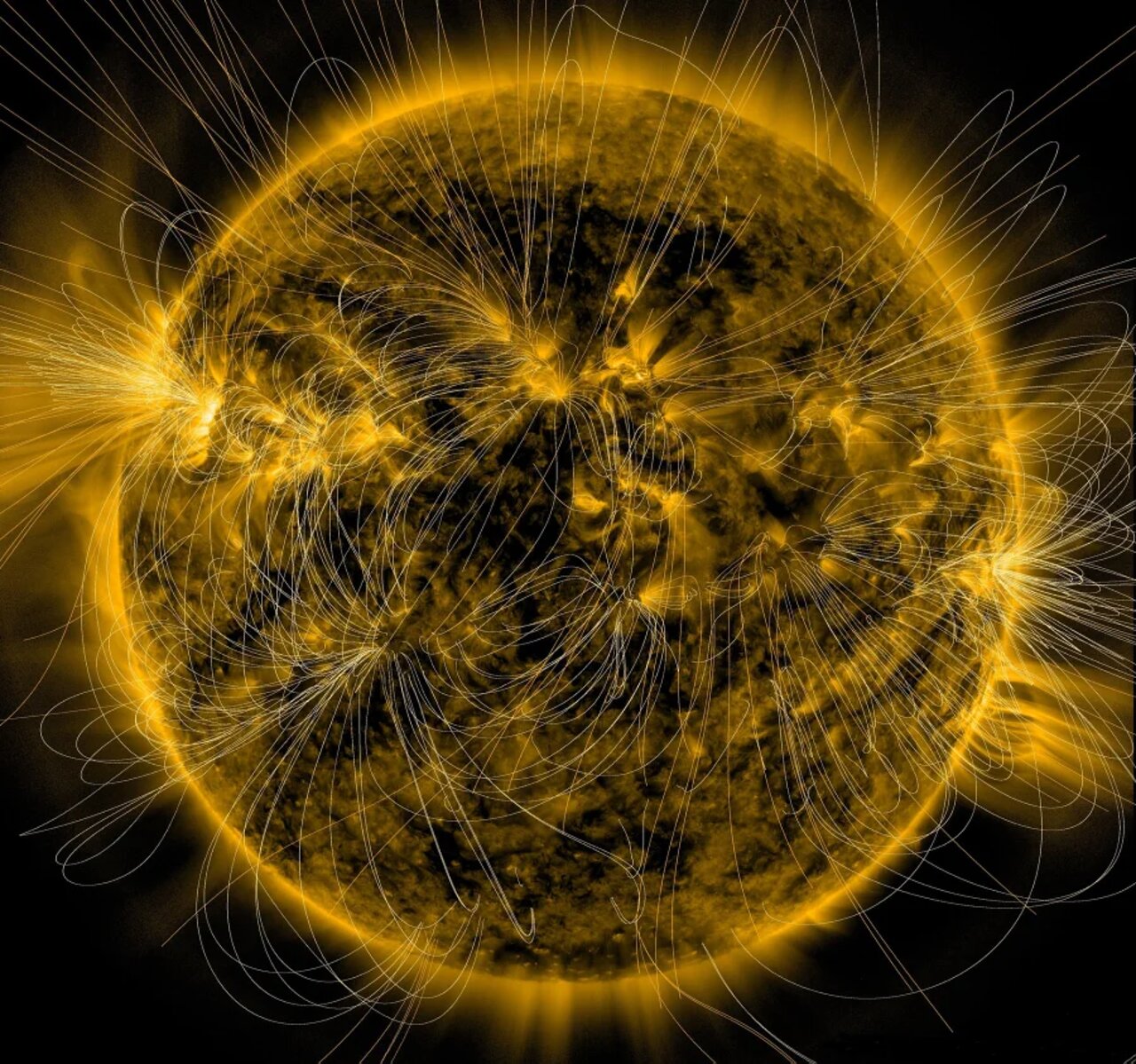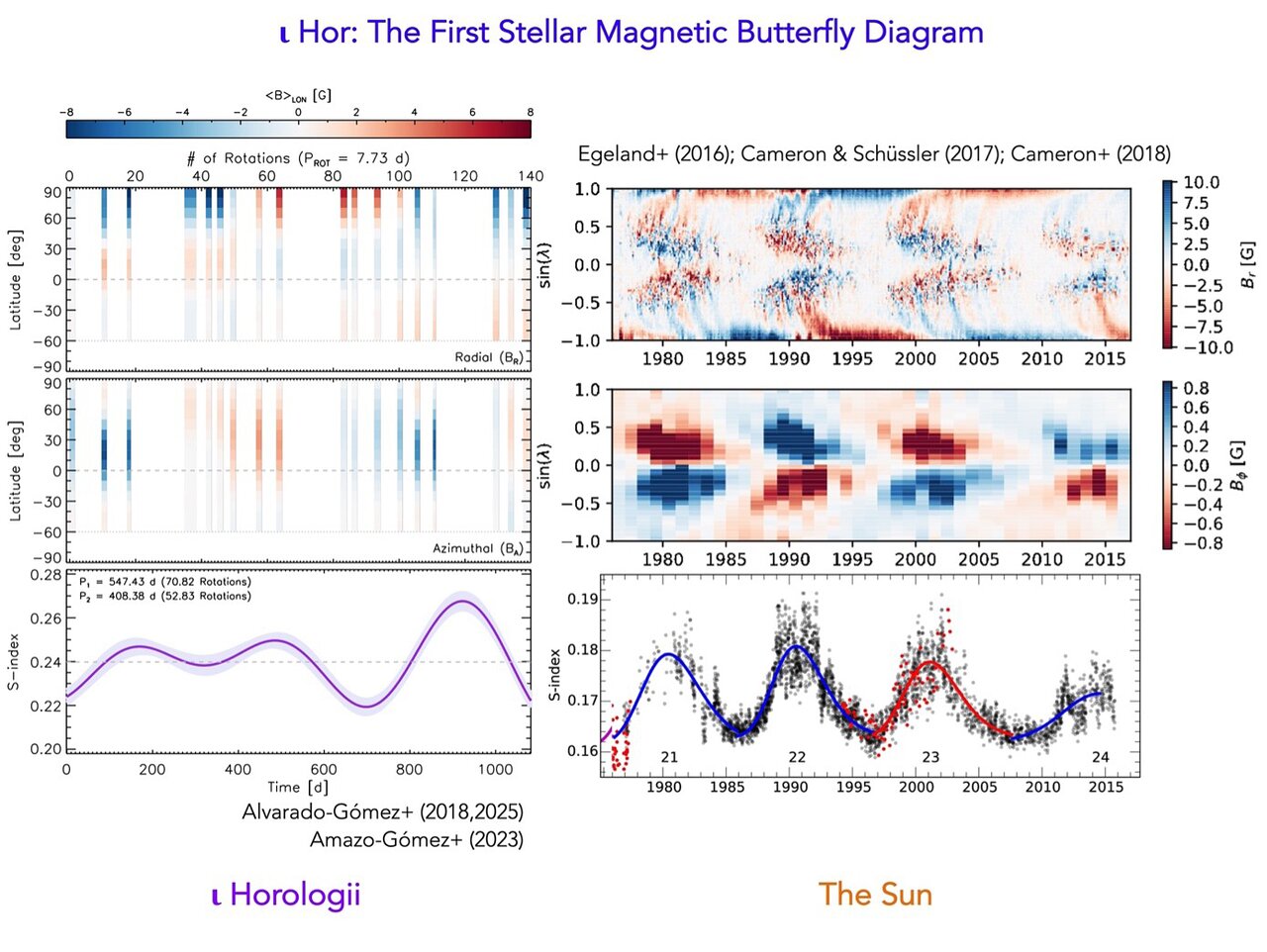- What is the solar magnetic cycle
- Why it’s challenging to track the magnetic cycle of another star
- How to catch magnetic butterflies beyond our solar system
Over the last year, we have seen some stunning auroras in both the northern and southern hemispheres, known as the Aurora Borealis and Australis, respectively. We have the Sun’s activity cycle to thank for these spectacular light shows, with the activity itself being driven by the solar magnetic field. But while astronomers have observed the Sun’s magnetic activity for centuries, there’s still much they don’t know about the magnetic field itself, such as where and how it’s formed.
One way in which researchers are trying to better understand the Sun’s magnetic field is by finding stars comparable to the Sun with activity cycles to see if their magnetic field works in a similar way. In a series of papers, including one just accepted for publication in Astronomy & Astrophysics, a global team of researchers has now uncovered the magnetic cycle of another star, Iota Horologii.
What’s a magnetic cycle?
Before we jump ahead into the research, it first helps to understand exactly what the Sun’s magnetic field is doing and what astronomers already know.
We can think of the Sun and its global magnetic field as a giant bar magnet, with its own red north and blue south poles — except in this case, the magnetic poles don’t always stay in the same place. Over a period of about 11 years, the bar magnet flips upside down as our Sun’s global magnetic field completely changes direction. After another 11 years, it flips back, completing a 22-year cycle known as the magnetic cycle.

The Sun’s magnetic field drives solar activity, which presents itself as solar flares, sunspots, and coronal mass ejections among others. These are all visible and measurable changes to the Sun’s surface and atmosphere that are caused by parts of the magnetic field twisting and tangling, occasionally even breaking and reconnecting, as the Sun rotates. As the global magnetic field shifts in polarity, it becomes more complex and dynamic, generating more magnetic activity on the surface and creating more sunspots. When the magnetic field is calmer, we see fewer sunspots being present and weaker solar activity. On Earth, we see fewer auroras during the solar minimum and more at the peak of solar activity.
Astronomers are still trying to understand how the Sun’s magnetic field is generated, and if this mechanism is the same for all stars. This all-encompassing theory of celestial magnetic fields, called the Dynamo Theory, needs to be able to explain all of this and more: how and where is the magnetic field generated? How does it result, in the case of the Sun, in an 11-year activity cycle and a 22-year magnetic cycle?
The fact that the Sun is the only star with a magnetic field studied in detail has made it very challenging to develop a theory of stellar magnetic fields. “All of these physical parameters of the Sun, they are fixed. We can’t change them. So, progress was very difficult in this area,” says Julián Alvarado-Gómez, a researcher at the Leibniz Institute for Astrophysics in Potsdam (AIP), and lead author of the new study.
Looking outside our solar system
Julián and his team wanted to look Far beyond the Sun in a campaign to uncover the magnetic cycle of another star in such detail that it could be compared to our host star. Considering astronomers needed centuries of observed changes on the surface of the Sun to connect them to its magnetic cycle, it’s quite the task to do the same for another star.
First, you must determine the type of stellar activity the star has on its surface. In the case of the Sun, this activity is characterised by small dark patches (spots) accompanied by large bright features (called faculae or plages). By measuring the signatures these features introduce in the stellar spectrum (this is the denomination astronomers give to the decomposition of the light in its different colors – just like in a rainbow), it is possible to determine if the star has more or less spots than the Sun or which features cover more area on the surface of the star.
Moreover, in some cases it is possible to measure the spectral response to the magnetic field on the star’s surface. This is known as the Zeeman effect, which causes spectral lines to split into multiple components in a magnetic field. By using a spectropolarimeter to analyse the polarisation and splitting of these spectral lines, it is possible to calculate the strength and, in some cases, the direction of the magnetic field, particularly the line-of-sight component (the direction pointing towards the observer).
Next, astronomers need to look for a young star, as younger stars often have a quicker and more active cycle, which is thought to be due to their faster rotation speeds. This makes them ideal targets, since they exhibit more pronounced differences in their spectra throughout their cycles, and only need to be observed for a short period of a few years.
A star like Iota Horologii (iota Hor), located approximately 56 light-years away from us, turned out to be the ideal target for Julián and his team. It’s nearby, at 600 million years old it’s rather young for a star, and it has a similar size, mass and surface temperature to our Sun. (It also happens to host a planet in an Earth-like orbit.)
Previous studies had estimated that iota Hor could have an activity cycle of just 1.6 years. This was short enough for the team to confirm this cycle period and to further study the star’s magnetic cycle without needing decades of telescope time.
Tracking Iota Horologii from a remote Chilean desert
The team began their campaign to study iota Hor in 2015 by trying to first confirm its stellar magnetic cycle. From the beginning, they used the High Accuracy Radial velocity Planet Searcher (HARPS) instrument, attached to ESO’s 3.6-metre Telescope at the La Silla Observatory in Chile. It’s one of only a few instruments globally that can help astronomers to map the activity of stars, as it is able to take spectra in polarised light (spectropolarimetric data), which tells us about a star’s magnetic fields.
“Given the position of the target of interest, iota Hor, there was no other facility that could have been used to obtain such high-quality spectropolarimetric data,” says Gaitee Hussain, Head of Science Engagement and Oversight at the European Space Agency, and previously an astronomer at ESO.
The team were able to confirm the important characteristics of the star, including its rotation period, activity cycles and dominant features on its surface in the first two papers published in 2018 and 2023.
They kept observing iota Hor, setting their initial end date based on the Sun’s magnetic cycle duration relative to its activity cycle. Julian says he was thinking at the time: “We don’t know if [the magnetic cycle]’s going to be double the activity period, like the sun, it’s just maybe an assumption — it might be that in other stars it’s different.”
The observations were taken in two-week blocks, scheduled every two months for three consecutive years (2015-2018). The researchers had to be on-site at La Silla for these two-week periods, meaning they were present for at least 18 two-week periods in the last three years. This often overlapped with important events, as Eliana M. Amazo-Gómez, a postdoctoral researcher at AIP and co-author on the latest paper, notes: “The effort is not just technological or scientific, but human. Some of the team would be spending Christmas and New Year’s Eve with no family around, but with the telescope and stars. And well, since stellar magnetic cycles don’t take holidays, neither could we.”
“The success of this study is not just about cutting-edge technology, but also about the people who made this happen, even when it meant being far from home,” she says, including the “strong observing support by the La Silla Observatory staff.”
It’s quite the opportunity being onsite, as Gaitee reflects: “The experience of monitoring the conditions, adjusting your observing strategy accordingly and seeing the data come in, in real-time, is a unique experience that every astronomer should experience at least once in their careers.”
They ended up with 199 separate nights of observations to use for the study. “This was really just unprecedented; it was a lot of time dedicated to a single star,” says Julian.
Catching a magnetic butterfly
Their research revealed that iota Hor undergoes a full magnetic cycle about once every 2.1 years. Moreover, by continuously observing iota Hor, the team was able to reconstruct its magnetic cycle using a technique called Zeeman-Doppler imaging.
In the Sun, sunspots usually come in pairs, one with positive polarity and one with negative polarity; this technique allows astronomers to identify spots on a star by imaging the different polarities covering its surface. The researchers then plotted their images of the polarised light from iota Hor to see how the surface changes over time. This final graph is known as a butterfly diagram, so-called because of the shape it has when the map is done for the surface of the Sun. By plotting this graph for iota Hor, they’ve created the first “butterfly diagram” for a star other than our Sun.

Through producing this “butterfly diagram” for another star, they were able to successfully confirm that the star displays a Sun-like behaviour, as its activity cycle is linked to its magnetic cycle.
Looking beyond our Sun
As in the name of this campaign, the team were never going to stop at just comparing iota Hor and the Sun. Their goal is to create a bank of Sun-like stars to study, and this is just the beginning.
“Thanks to this study, the magnetic cycle of iota Hor has now the most stringent constraints on its properties than any other star - only surpassed by our Sun,” says Julián.
“The results not only provide a direct analogue to the solar magnetic cycle in a much younger star but also establish a new benchmark for how we map and interpret dynamos across stellar evolution,” he says.
To continue their work in unravelling stellar magnetic fields, Julián and the team are next looking to collect data on an entire group of stars in a similar region, with the hopes of confirming the presence of magnetic fields.
So, to those interested in cracking the Dynamo Theory, go out and capture those magnetic butterflies.
Links
Biography Amy Briggs
Amy is a recent science communication graduate from the Australian National University. Before coming to learn from the COMMS team at the ESO, she worked for the Australian Academy of Technological Sciences and Engineering (ATSE) as a Communications Coordinator and as an Editorial Coordinator for the youth magazine Careers with STEM.
She has also written for the Sunday Space column in The Canberra Times, ABC Science, and the CSIRO’s Double Helix magazine.
She has a passion for storytelling, reading, and unihockey.





